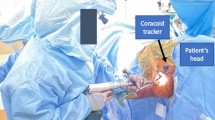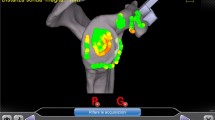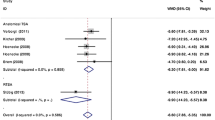Abstract
Background
While the use of computer-assisted navigation systems in prosthetic implantation is steadily increasing, its utility in reverse shoulder arthroplasty (RSA) remains unclear. The purpose of this study was to evaluate the clinical utility of an intraoperative navigation system in patients undergoing RSA.
Materials and methods
Patients undergoing navigated or standard RSA at a single institution between September 2020 and December 2021 were prospectively enrolled. Exclusion criteria included noncompliance with study procedures or humeral fracture. Outcome measures included postoperative version and inclination, range of motion (ROM), complications, and patient-reported outcome measurements (PROMs: American Shoulder and Elbow Surgeons score [ASES], Disabilities of the Arm, Shoulder, and Hand score [DASH], Simple Shoulder Test [SST], and Visual Analog Scale [VAS]) at final follow-up.
Results
The final cohort contained 16 patients with navigation and 17 with standard RSA at a mean follow-up of 16 months (range 12–18 months). Average age was 72 years (range 66–80 years), 8 male (24%) and 25 female (76%). There were no differences in demographics between groups (p > 0.05). At baseline, the navigated group had a greater proportion of Walch B1 and B2 glenoids (p = 0.04). There were no differences between groups regarding baseplate type and native/planned/postoperative glenoid version and inclination. In both groups, planned and postoperative versions were not significantly different (p = 0.76). Patients who did not have navigation demonstrated significant differences between planned and postoperative inclination (p = 0.04), while those with navigation did not (p = 0.09). PROM scores did not differ between groups at final follow-up for SST (p = 0.64), DASH (p = 0.38), ASES (p = 0.77), or VAS (p = 0.1). No difference in final ROM was found between groups (p > 0.05). Over 50% of all screws in both groups were positioned outside the second cortex (p = 0.37), albeit with no complications.
Conclusions
There were no statistically significant differences in ROM, PROMs, and satisfaction between patients receiving computer-navigated and standard RSA at a short-term follow-up. Despite more severe preoperative glenoid erosion in the navigated group, all patients were able to achieve an appropriate neutral axis postoperatively. The cost effectiveness and appropriate use of computer-navigated RSA warrant specific investigation in future studies.
Level of evidence: II, prospective cohort study.
Trial registration: 9/1/2020 to 12/31/2021.



Similar content being viewed by others
Data availability
All data generated or analyzed during this study are included in this published article [and its supplementary information files].
Abbreviations
- RSA:
-
Reverse shoulder arthroplasty
- PROMs:
-
Patient-reported outcome measurements
- ASES:
-
American shoulder and elbow surgeons
- DASH:
-
Disabilities of the arm, shoulder, and hand
- SST:
-
Simple shoulder test
- VAS:
-
Visual analog scale
- IR:
-
Internal rotation
- ER:
-
External rotation
- 3D:
-
Three-dimensional
- 2D:
-
Two-dimensional
References
Codsi MJ, Iannotti JP (2008) The effect of screw position on the initial fixation of a reverse total shoulder prosthesis in a glenoid with a cavitary bone defect. J Shoulder Elbow Surg 17(3):479–486. https://doi.org/10.1016/j.jse.2007.09.002
Harman M, Frankle M, Vasey M, Banks S (2005) Initial glenoid component fixation in “reverse” total shoulder arthroplasty: a biomechanical evaluation. J Shoulder Elbow Surg 14(1):162S-S167. https://doi.org/10.1016/j.jse.2004.09.030
Wagner ER, Muniz AR, Chang MJ, Hunt T, Welp KM, Woodmass JM et al (2021) Neuroapraxia and early complications after reverse shoulder arthroplasty with glenoid bone grafting. J Shoulder Elbow Surg 30(2):258–264. https://doi.org/10.1016/j.jse.2020.05.004
Bohsali KI, Bois AJ, Wirth MA (2017) Complications of shoulder arthroplasty. J Bone Jt Surg Am 99(3):256–269. https://doi.org/10.2106/jbjs.16.00935
Iannotti JP, Weiner S, Rodriguez E, Subhas N, Patterson TE, Jun BJ et al (2015) Three-dimensional imaging and templating improve glenoid implant positioning. J Bone Jt Surg Am 97(8):651–658. https://doi.org/10.2106/jbjs.N.00493
Ho JC, Thakar O, Chan WW, Nicholson T, Williams GR, Namdari S (2020) Early radiographic failure of reverse total shoulder arthroplasty with structural bone graft for glenoid bone loss. J Shoulder Elbow Surg 29(3):550–560. https://doi.org/10.1016/j.jse.2019.07.035
Gutierrez S, Comiskey CAT, Luo ZP, Pupello DR, Frankle MA (2008) Range of impingement-free abduction and adduction deficit after reverse shoulder arthroplasty. Hierarchy of surgical and implant-design-related factors. J Bone Jt Surg Am 90(12):2606–2615. https://doi.org/10.2106/JBJS.H.00012
Humphrey CS, Kelly JD 2nd, Norris TR (2008) Optimizing glenosphere position and fixation in reverse shoulder arthroplasty, part two: the three-column concept. J Shoulder Elbow Surg 17(4):595–601. https://doi.org/10.1016/j.jse.2008.05.038
Middernacht B, De Roo PJ, Van Maele G, De Wilde LF (2008) Consequences of scapular anatomy for reversed total shoulder arthroplasty. Clin Orthop Relat Res 466(6):1410–1418. https://doi.org/10.1007/s11999-008-0187-6
Sirveaux F, Favard L, Oudet D, Huquet D, Walch G, Mole D (2004) Grammont inverted total shoulder arthroplasty in the treatment of glenohumeral osteoarthritis with massive rupture of the cuff. Results of a multicentre study of 80 shoulders. J Bone Jt Surg Br 86(3):388–395. https://doi.org/10.1302/0301-620x.86b3.14024
Walch G, Badet R, Boulahia A, Khoury A (1999) Morphologic study of the glenoid in primary glenohumeral osteoarthritis. J Arthroplasty 14(6):756–760. https://doi.org/10.1016/s0883-5403(99)90232-2
Nashikkar PS, Scholes CJ, Haber MD (2019) Computer navigation re-creates planned glenoid placement and reduces correction variability in total shoulder arthroplasty: an in vivo case-control study. J Shoulder Elbow Surg 28(12):e398–e409. https://doi.org/10.1016/j.jse.2019.04.037
Nguyen D, Ferreira LM, Brownhill JR, King GJ, Drosdowech DS, Faber KJ et al (2009) Improved accuracy of computer assisted glenoid implantation in total shoulder arthroplasty: an in-vitro randomized controlled trial. J Shoulder Elbow Surg 18(6):907–914. https://doi.org/10.1016/j.jse.2009.02.022
Theopold J, Pieroh P, Henkelmann R, Osterhoff G, Hepp P (2019) Real-time intraoperative 3D image intensifier-based navigation in reversed shoulder arthroplasty-analyses of image quality. BMC Musculoskelet Disord 20(1):262. https://doi.org/10.1186/s12891-019-2657-2
Bercik MJ, Kruse K 2nd, Yalizis M, Gauci MO, Chaoui J, Walch G (2016) A modification to the Walch classification of the glenoid in primary glenohumeral osteoarthritis using three-dimensional imaging. J Shoulder Elbow Surg 25(10):1601–1606. https://doi.org/10.1016/j.jse.2016.03.010
Friedman RJ, Hawthorne KB, Genez BM (1992) The use of computerized tomography in the measurement of glenoid version. J Bone Jt Surg Am 74(7):1032–1037
Lippitt SB, Harryman DT, Matsen FA, Lippitt S, Lippit S (1993) A practical tool for evaluating function: the simple shoulder test
Hoenecke HR Jr, Hermida JC, Dembitsky N, Patil S, D’Lima DD (2008) Optimizing glenoid component position using three-dimensional computed tomography reconstruction. J Shoulder Elbow Surg 17(4):637–641. https://doi.org/10.1016/j.jse.2007.11.021
Hill JM, Norris TR (2001) Long-term results of total shoulder arthroplasty following bone-grafting of the glenoid. J Bone Jt Surg Am 83(6):877–883
Rice RS, Sperling JW, Miletti J, Schleck C, Cofield RH (2008) Augmented glenoid component for bone deficiency in shoulder arthroplasty. Clin Orthop Relat Res 466(3):579–583. https://doi.org/10.1007/s11999-007-0104-4
Steinmann SP, Cofield RH (2000) Bone grafting for glenoid deficiency in total shoulder replacement. J Shoulder Elbow Surg 9(5):361–367. https://doi.org/10.1067/mse.2000.106921
Kersten AD, Flores-Hernandez C, Hoenecke HR, D’Lima DD (2015) Posterior augmented glenoid designs preserve more bone in biconcave glenoids. J Shoulder Elbow Surg 24(7):1135–1141. https://doi.org/10.1016/j.jse.2014.12.007
Knowles NK, Ferreira LM, Athwal GS (2015) Augmented glenoid component designs for type B2 erosions: a computational comparison by volume of bone removal and quality of remaining bone. J Shoulder Elbow Surg 24(8):1218–1226. https://doi.org/10.1016/j.jse.2014.12.018
Nabergoj M, Neyton L, Bothorel H, Ho SWL, Wang S, Chong XL et al (2021) Reverse shoulder arthroplasty with bony and metallic versus standard bony reconstruction for severe glenoid bone loss. A retrospective comparative cohort study. J Clin Med 10:22. https://doi.org/10.3390/jcm10225274
Youderian AR, Greene AT, Polakovic SV, Davis NZ, Parsons M, Papandrea RF et al (2023) Two-year clinical outcomes and complication rates in anatomic and reverse shoulder arthroplasty implanted with Exactech GPS© intraoperative navigation. J Shoulder Elbow Surg. https://doi.org/10.1016/j.jse.2023.05.021
Rol M, Favard L, Berhouet J, la Societe d’orthopedie de lO (2019) Factors associated with internal rotation outcomes after reverse shoulder arthroplasty. Orthop Traumatol Surg Res 105(8):1515–1519. https://doi.org/10.1016/j.otsr.2019.07.024
Al Yaseen M, Smart YW, Seyed-Safi P, Abdelmonem AH, Makki D, Morgan B et al (2022) Effect of implant size, version and rotator cuff tendon preservation on the outcome of reverse shoulder arthroplasty. Cureus 14(6):e25741. https://doi.org/10.7759/cureus.25741
Cheung EV, Sarkissian EJ, Sox-Harris A, Comer GC, Saleh JR, Diaz R et al (2018) Instability after reverse total shoulder arthroplasty. J Shoulder Elbow Surg 27(11):1946–1952. https://doi.org/10.1016/j.jse.2018.04.015
Virk M, Yip M, Liuzza L, Abdelshahed M, Paoli A, Grey S et al (2020) Clinical and radiographic outcomes with a posteriorly augmented glenoid for Walch B2, B3, and C glenoids in reverse total shoulder arthroplasty. J Shoulder Elbow Surg 29(5):e196–e204. https://doi.org/10.1016/j.jse.2019.09.031
Verborgt O, De Smedt T, Vanhees M, Clockaerts S, Parizel PM, Van Glabbeek F (2011) Accuracy of placement of the glenoid component in reversed shoulder arthroplasty with and without navigation. J Shoulder Elbow Surg 20(1):21–26. https://doi.org/10.1016/j.jse.2010.07.014
Roche CP, Stroud NJ, Flurin PH, Wright TW, Zuckerman JD, DiPaola MJ (2014) Reverse shoulder glenoid baseplate fixation: a comparison of flat-back versus curved-back designs and oval versus circular designs with 2 different offset glenospheres. J Shoulder Elbow Surg 23(9):1388–1394. https://doi.org/10.1016/j.jse.2014.01.050
Chae SW, Lee J, Han SH, Kim SY (2015) Inferior tilt fixation of the glenoid component in reverse total shoulder arthroplasty: a biomechanical study. Orthop Traumatol Surg Res 101(4):421–425. https://doi.org/10.1016/j.otsr.2015.03.009
Lévigne C, Garret J, Boileau P, Alami G, Favard L, Walch G (2011) Scapular notching in reverse shoulder arthroplasty: is it important to avoid it and how? Clin Orthop Relat Res 469(9):2512–2520. https://doi.org/10.1007/s11999-010-1695-8
Wang AW, Hayes A, Gibbons R, Mackie KE (2020) Computer navigation of the glenoid component in reverse total shoulder arthroplasty: a clinical trial to evaluate the learning curve. J Shoulder Elbow Surg 29(3):617–623. https://doi.org/10.1016/j.jse.2019.08.012
Hones KM, King JJ, Schoch BS, Struk AM, Farmer KW, Wright TW (2021) The in vivo impact of computer navigation on screw number and length in reverse total shoulder arthroplasty. J Shoulder Elbow Surg 30(10):e629–e635. https://doi.org/10.1016/j.jse.2021.01.017
Velasquez Garcia A, Abdo G (2023) Does computer-assisted navigation improve baseplate screw configuration in reverse shoulder arthroplasty? A systematic review and meta-analysis of comparative studies. J Orthop 36:29–35. https://doi.org/10.1016/j.jor.2022.12.008
Jahic D, Suero EM, Marjanovic B (2021) The use of computer navigation and patient specific instrumentation in shoulder arthroplasty: everyday practice, just for special cases or actually teaching a surgeon? Acta Inform Med 29(2):130–133. https://doi.org/10.5455/aim.2021.29.130-133
Hoenecke HR Jr, Hermida JC, Flores-Hernandez C, D’Lima DD (2010) Accuracy of CT-based measurements of glenoid version for total shoulder arthroplasty. J Shoulder Elbow Surg 19(2):166–171. https://doi.org/10.1016/j.jse.2009.08.009
Rouleau DM, Kidder JF, Pons-Villanueva J, Dynamidis S, Defranco M, Walch G (2010) Glenoid version: how to measure it? Validity of different methods in two-dimensional computed tomography scans. J Shoulder Elbow Surg 19(8):1230–1237. https://doi.org/10.1016/j.jse.2010.01.027
Scalise JJ, Codsi MJ, Bryan J, Brems JJ, Iannotti JP (2008) The influence of three-dimensional computed tomography images of the shoulder in preoperative planning for total shoulder arthroplasty. J Bone Jt Surg Am 90(11):2438–2445. https://doi.org/10.2106/JBJS.G.01341
Grubhofer F, Muniz Martinez AR, Ernstbrunner L, Haberli J, Selig ME, Yi K et al (2021) Speed of recovery of the most commonly performed shoulder surgeries. JSES Int 5(4):776–781. https://doi.org/10.1016/j.jseint.2021.03.007
Cabarcas BC, Gowd AK, Liu JN, Cvetanovich GL, Erickson BJ, Romeo AA et al (2018) Establishing maximum medical improvement following reverse total shoulder arthroplasty for rotator cuff deficiency. J Shoulder Elbow Surg 27(9):1721–1731. https://doi.org/10.1016/j.jse.2018.05.029
Huber J, Irlenbusch U, Kääb MJ, Reuther F, Kohut G, Judge A (2020) Treatment effects of reverse total shoulder arthroplasty—a simple method to measure outcomes at 6, 12, 24 and 60 months for each patient. BMC Musculoskelet Disord 21(1):397. https://doi.org/10.1186/s12891-020-03427-7
Acknowledgements
We would like to thank Exactech for making the intraoperative navigation system available to us free of charge.
Funding
This study was conducted without funds.
Author information
Authors and Affiliations
Contributions
EG cooperated to the conception, design of the work, and interpretation of data, approved the submitted version, and agreed both to be personally accountable for the author's own contributions and to ensure that questions related to the accuracy or integrity of any part of the work, even ones in which the author was not personally involved, are appropriately investigated, resolved, and the resolution documented in the literature. SMP contributed to the acquisition and analysis, drafted the work or substantially, revised it AND approved the submitted version, and agreed both to be personally accountable for the author's own contributions and to ensure that questions related to the accuracy or integrity of any part of the work, even ones in which the author was not personally involved, are appropriately investigated, resolved, and the resolution documented in the literature. OP interpreted the data, approved the submitted version, and agreed both to be personally accountable for the author's own contributions and to ensure that questions related to the accuracy or integrity of any part of the work, even ones in which the author was not personally involved, are appropriately investigated, resolved, and the resolution documented in the literature. EJB. drafted the work or substantially revised it, approved the submitted version, and agreed both to be personally accountable for the author's own contributions and to ensure that questions related to the accuracy or integrity of any part of the work, even ones in which the author was not personally involved, are appropriately investigated, resolved, and the resolution documented in the literature. HHP drafted the work or substantially revised it, approved the submitted version and agreed both to be personally accountable for the author's own contributions and to ensure that questions related to the accuracy or integrity of any part of the work, even ones in which the author was not personally involved, are appropriately investigated, resolved, and the resolution documented in the literature. AR drafted the work or substantially revised it, approved the submitted version, and agreed both to be personally accountable for the author's own contributions and to ensure that questions related to the accuracy or integrity of any part of the work, even ones in which the author was not personally involved, are appropriately investigated, resolved, and the resolution documented in the literature. ADC drafted the work or substantially revised it, approved the submitted version and agreed both to be personally accountable for the author's own contributions and to ensure that questions related to the accuracy or integrity of any part of the work, even ones in which the author was not personally involved, are appropriately investigated, resolved, and the resolution documented in the literature.
Corresponding author
Ethics declarations
Competing interests
The authors declare that they have no competing interests.
Ethics approval and consent to participate
This prospective cohort investigation was reviewed and granted ethics approval by Sapienza University of Rome institutional Review Board (05/2020) and conducted in accordance with the Declaration of Helsinki. For all participants, informed consent was obtained prior to enrollment.
Consent for publication
Not applicable.
Additional information
Publisher's Note
Springer Nature remains neutral with regard to jurisdictional claims in published maps and institutional affiliations.
Rights and permissions
Springer Nature or its licensor (e.g. a society or other partner) holds exclusive rights to this article under a publishing agreement with the author(s) or other rightsholder(s); author self-archiving of the accepted manuscript version of this article is solely governed by the terms of such publishing agreement and applicable law.
About this article
Cite this article
Gaj, E., Pagnotta, S.M., Berlinberg, E.J. et al. Intraoperative navigation system use increases accuracy of glenoid component inclination but not functional outcomes in reverse total shoulder arthroplasty: a prospective comparative study. Arch Orthop Trauma Surg 144, 91–102 (2024). https://doi.org/10.1007/s00402-023-05038-y
Received:
Accepted:
Published:
Issue Date:
DOI: https://doi.org/10.1007/s00402-023-05038-y




